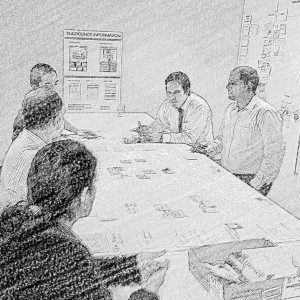Cohesion
A cohesive team is great to be in. There is energy and focus within a cohesive team that makes the team stand out from others. Not only does it feel good, but cohesion has been shown to be related to a bunch of good things: team performance, team efficiency, team members putting in effort out of hours, lower absenteeism. So what is the magic of cohesion, and how can you get some for your team?
First, what do we mean when we say “cohesion”? As is often the case, the most vivid expressions come from people we’ve worked with:
“[Cohesion is] .. when you stay up late or back at work to get something done, because you know the people you are working with are doing the same, and YOU ALL need to get the job done.”
– Participant in Science of Teams workshop at AgilePT, Porto, May 2015
We all have a feel for what cohesion looks like in practice, but in order to assess it and work with it, it’s important to note that it comes in two different flavours:
- Social cohesion is probably what people first think of when you mention cohesion. It’s a shared liking or attraction to the group, emotional bonds of friendship and caring among group members, and enjoyment of each other’s company. This is the team that has lunch together because they want to spend time together, this is where the team members talk about how great the team is, this is where you feel good about working in the team.
- Task cohesion is a team’s shared commitment to their goal, as well as motivation to coordinate team efforts to achieve common work-related goals. Teams that have people that don’t particularly like each other, but nevertheless work hard together to get the job done, are high on task cohesion. This is the team where everyone wants to achieve the team goal and puts in the effort to get it done.
So which kind of cohesion was our workshop participant from Portugal talking about?[1]
Out of the two types of cohesion, social cohesion is easier to instil in your team. But while social cohesion does contributes to productivity and efficiency, task cohesion contributes more.
Getting some cohesion
- Suppose you have a team with people who don’t know each other that well. How can you build the cohesion they need to form an effective team? Let’s start with some social cohesion. Pair people off; they’re going to talk to each other for 10 minutes, then move on to another pairing. The task of each pair is to discover as many things that they have in common as possible (from both inside and outside their working life).
- Task cohesion is tougher. Clarifying shared goals is an effective way to build task cohesion. Using the “Product box” method, where the product is the team, can do this in an enjoyable way. The team also ends up with a handy artifact they can use to decorate their work area.
- Another way to increase task cohesion is to use group-based rewards, not individual ones.
[1] It was task cohesion, but there’s also a bit of social cohesion implied in the reason giving for working back, i.e. that the others in the team are doing it too.
